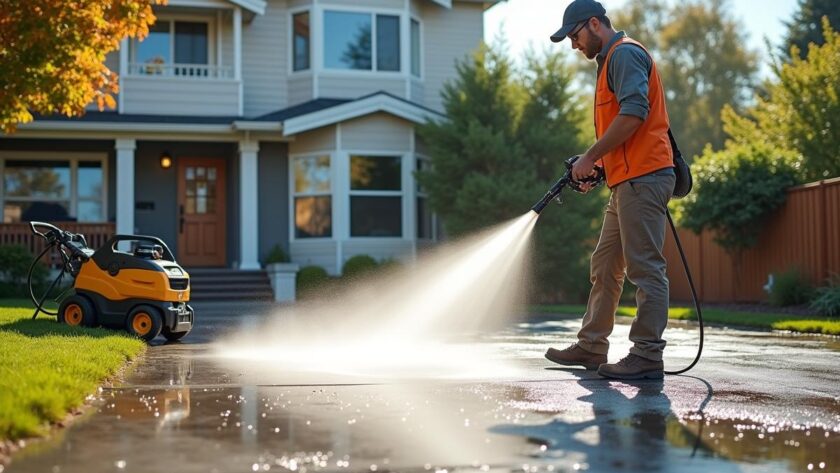Pressure washing can be a game-changer for homeowners looking to keep exterior surfaces in excellent shape. It goes beyond simply rinsing off dirt, offering powerful cleaning potential for everything from decks to patios. By learning a range of effective techniques and selecting the right tools, you can keep various areas of your property pristine.
Contents
Protecting and Enhancing Your Exterior Surfaces
Regular exterior cleaning not only preserves your home’s appearance but also helps extend the lifespan of materials. Strong jets of water loosen debris, while certain methods are gentle enough for delicate surfaces. For example, power washing employs high-pressure sprays to remove stubborn grime from concrete or brick. Soft washing relies on lower pressure with specialized solutions, which can be safer for wood or other sensitive finishes.
Even with a solid routine, areas like the driveway or patio can accumulate oil stains and general wear over time. Driveway cleaning becomes simpler when you use the right machine setting and cleaning agents to tackle tough patches. Likewise, patio cleaning keeps outdoor living spaces looking fresh and inviting, especially after rainy seasons or social events.
Key Areas to Tackle
Driveways and walkways accumulate dirt, oil, and grime. Proper driveway cleaning ensures your home’s first impression remains welcoming. Deck cleaning, on the other hand, keeps wood surfaces free of mildew and algae. Inspect any seals or stains on the deck before you start, and consider reapplication of protective coatings afterward.
Gutters often go unnoticed until rainwater overflows. Gutter cleaning with the aid of a pressure washer can be quick, so long as you adjust the pressure to avoid damaging seams. Fence cleaning also benefits from the same approach. By removing layers of dirt and moss, you can restore the fence’s original color and allow any protective treatments to work effectively.
Different Washing Methods for Various Surfaces
Not all cleaning tasks require the same level of force. High pressure washing can be ideal for driveways and sidewalks but might be too intense for delicate siding or painted areas. Exterior washing of vinyl or wood siding may need a soft washing technique, where mild water pressure and specific detergents reduce the risk of damage. If you’re unsure which approach fits your project, test a small, less noticeable patch first.
Safe Approaches for Roofs
Roof cleaning is a task many homeowners hesitate to attempt. Using an overly aggressive spray can lift shingles or force water under roofing materials. Soft washing methods work well here because they reduce the chance of leaks or cracks. Follow safe work practices when operating on a roof, and aim to remove leaves, algae, and mold with minimal disturbance to your roofing structure. Hot water pressure washing might help dissolve stubborn debris, but only if you use it carefully.
Eliminating Stubborn Stains
Sometimes, grime goes beyond everyday dirt. Concrete cleaning turns more effective when you combine the force of a spray with a compatible detergent. This approach also helps deal with deep-seated stains in garage floors or outdoor steps. Graffiti removal poses another challenge, especially on porous materials like brick. With the right cleaning solution, jet washing can loosen paint particles without leaving a patchy finish. If graffiti persists after one session, repeated treatment could be necessary.
Options for Equipment and Services
Investing in your own pressure washing equipment is an option if you perform cleaning tasks regularly. Machines range from compact models suitable for home use to powerful units more common in industrial pressure washing. For occasional tasks, a pressure washer rental might be more cost-effective. Just make sure to choose a machine with appropriate pressure settings, and inspect all hoses and nozzles for safety.
Eco-friendly pressure washing is gaining popularity. By using biodegradable detergents and water-saving techniques, homeowners minimize their environmental impact. Commercial pressure washing and industrial pressure cleaning typically involve large-scale tasks on building facades, parking lots, and manufacturing sites. These jobs often benefit from specialized equipment and experienced operators.
Working with Professional Cleaning Services
If you lack the time, expertise, or desire to handle these tasks yourself, professional cleaning services are worth exploring. Residential power washing packages often combine house washing, gutter cleaning, and other specialized treatments like fence cleaning. Those who need more comprehensive help, such as building facade cleaning for commercial properties, might consider companies specializing in exterior washing solutions.
When hiring, confirm the team’s experience with your particular surface type. Ask about any detergents they plan to use, especially if you have concerns about landscaping or pets. Reputable services should provide details on how they plan to protect your property during the job.
Maintaining A Clean Deck, Driveway, and Beyond
Deck cleaning is crucial if you enjoy outdoor gatherings. After sweeping away leaves, start with lower pressure to see how the wood reacts. Increase the force gradually to avoid gouging the board. For hardwood decks, you might opt for a slightly higher setting than what you’d use on softwood. After cleaning, apply a sealer or stain to extend the deck’s durability and showcase the wood’s natural beauty.
Driveway cleaning might require a bit more power, especially if you face oil stains or embedded grime. A pre-treatment solution can loosen grease, making it simpler to wash everything away. Rinse thoroughly to eliminate any residue that could harm nearby plants or lawns. Consider pressure cleaning your driveway once or twice each year to reduce the risk of cracks forming from trapped moisture.
Fence and Gutter Upkeep
Fences take a beating from rain, snow, and UV rays. When you notice discoloration or algae growth, consider using a moderate spray setting. Spot-treat any areas with stubborn stains. Let the wood dry before you decide on painting or staining to ensure the best coverage.
Gutter cleaning is often overlooked, but clogged gutters can lead to water damage and other structural problems. A small-pressure nozzle can clear out leaves efficiently, but make sure to direct the spray away from seams. Double-check for any leaks or standing water after you’re done.
Handling More Challenging Tasks
Some jobs demand specialized methods and tools. Roof cleaning, for instance, might be dangerous if done without proper safety equipment. When working on roofs, harnesses and stable ladders are essential. Soft washing proves safest for most roofing materials, using low pressure and detergent to gently remove moss.
Graffiti removal becomes simpler if you address it quickly. Spray paint adheres less to surfaces that haven’t fully absorbed the pigment. If you spot new graffiti, treat it as soon as possible to achieve better results. Medium to high pressure combined with appropriate solutions generally strips off most paint from metal, concrete, and brick.
Preparing for Industrial or Commercial Needs
Commercial pressure washing might include buildings, parking structures, and loading docks. In these settings, power cleaning eliminates not just dirt but also chemical residues. Industrial pressure cleaning usually calls for heavy-duty machines that can handle large surface areas and thicker coatings of grime. If you manage a commercial property, schedule regular insect removal, graffiti cleanups, and surface refreshes. Building facade cleaning can significantly improve customer perception.
Eco-friendly pressure washing techniques should factor into large-scale jobs too, especially if runoff goes near public drains or natural areas. Look for detergents that break down quickly and pose minimal harm to local water systems. Hot water pressure washing can also help sanitize surfaces, reducing the need for harsh chemicals.
Choosing the Right Approach for Long-Term Care
In any setting, the choice between renting a machine or contacting a pressure washing services provider depends on your comfort level and budget. A pressure washer rental is useful if you have sporadic needs but want to handle jobs independently. Owning your own setup works better when you foresee consistent usage. Just remember to check each machine’s PSI (pounds per square inch) and GPM (gallons per minute) rating. Matching these metrics to your tasks prevents overkill or disappointment.
Keeping soft washing in mind will serve you well for delicate surfaces like cedar shake siding or certain roofing materials. When in doubt, consult professionals or experiment with the least powerful method first. With practice, you’ll identify which approach works best for each project.
Consistency and Simple Tricks
Regular maintenance saves you time and money. By washing surfaces before grime sets in too deeply, you reduce wear and tear. Seasonal checks on your house washing and fence cleaning routine can catch problems early. If you notice rust spots on concrete, treat them quickly so they don’t become permanent blemishes.
Proper storage and cleaning of your tools extends their lifespan. Drain hoses and store them in a dry place to prevent freezing and cracking. Inspect nozzles for wear so you maintain an even spray pattern. Check for leaks in the hose and connections, and replace seals as needed.
Staying vigilant and using the proper techniques will maintain curb appeal and preserve your property’s value. Each surface, from the driveway to the fence, can look fantastic with thoughtful care. By experimenting with different nozzles, detergents, and pressure levels, you’ll discover new ways to keep surfaces in top-notch condition.




